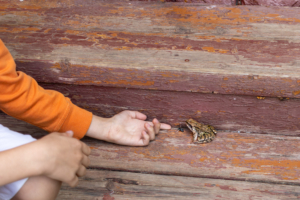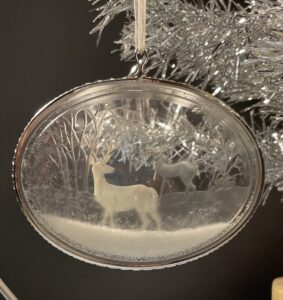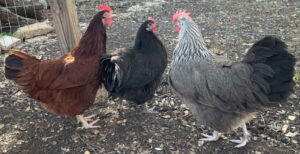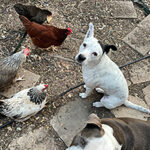Hannah and Hopalot
Hannah and Hopalot
Hannah was sitting on the living room floor talking to her doll, Samantha, when Henry came home. Henry was her big brother, and he seemed all excited about something he had in a box.
“What do you got there, Henry?” Hannah asked.
“Oh, it’s great!” Henry said. “I can’t wait to show you.”
“Well, what is it?” Hannah asked.
When he got to the kitchen, Henry said, “I got a frog!”
Mom, Dad, and Hannah all at the same time said, “A frog?!”
Henry opened the box and there was a tiny, green tree frog with big red eyes and long red toes. Hannah looked at the frog and her eyebrows crawled up her face, her nose pinched together, her tongue stuck out, and she shook her head. When she could talk again, she said, “That’s the most disgusting thing I’ve ever seen in the world!”
Mom and Dad looked at each other, and Dad asked, “Well, what would you feed him?”

For the next week, Henry spent all his free time playing with the frog in his room. On Friday after school, Henry came walking out of his room. Hannah looked up from the living room floor where she was sitting and playing, and she saw that the frog was stuck on the side of Henry’s face! Her eyebrows jumped up like they were going to run away, her nose pinched together, her tongue stuck out, and she shook her head. She could hardly even scream enough to say, “That’s so disgusting!”
But Hannah could hear that her parents and Henry were talking about Henry’s plan to spend the night and the next day at his friend’s house.
Henry called, “Yeah, but Hannah can take care of the frog when I’m gone,” as he walked back towards his room.
Hannah marched straight into the kitchen, where Mom was sitting at the table writing checks or bills or something like that, and Dad was making oatmeal cookies. Mom listened while Hannah begged and pleaded with her to get rid of the frog, to not make her take care of it.
Mom said, ““Hannah, do you remember at church last Sunday, we heard that ‘God saw everything that he had made, and behold, it was very good?’”
Hannah nodded.
“It may not always be easy, honey,” Mom continued, “But we should always look for the good in all the things made by God. Taking care of the frog will be a good experience for you. It’s only for one day, and we’ll help you.”
Dad put a cup of raisins in the measuring cup, and then Hannah poured them into the big bowl. Suddenly, Hannah was very glad to be kneeling on the stool because there was the frog, hopping, hopping and hopping all across the kitchen floor! Hannah got down off the stool and walked around the counter to watch where the frog went.
Before you know it, the frog hopped right over to where Mom was sitting, and it popped onto the side of her leg.
Well, you know what happened to Hannah’s eyebrows then.
Mom reached her hand down like a cup beneath the frog and he popped into her hand. She lifted the frog up to the front of her face. Hannah suddenly realized she was standing right next to Mom, leaning against her shoulder and looking right at the tiny frog.
Mom said, “Hannah, do you know he’s warm? He feels warm when he sits in your hand.”
Hannah just looked and looked and looked, and her fingers grabbed the sleeve of Mom’s shirt as she stared at this tiny green frog. Hannah noticed that his little body would get bigger and smaller, bigger and smaller, bigger and smaller.
While she still stared at him, Hannah asked, “Mom, is he breathing?”
“Yes, honey,” Mom said. “Of course he’s breathing.”
Hannah noticed that the frog’s eyes were moving and that he was looking at her, and then he was looking at Mom, and then he was looking at her again.
Now the little frog lifted his little feet with his long toes and started walking up Mom’s hand and onto her arm, where her sleeve was rolled up.
Hannah realized the frog was coming closer to get a better look at her. She leaned her head against Mom’s shoulder and looked closely at the frog and the frog turned its head to the side and looked closely at Hannah.
Mom said to Hannah, “He feels good. Do you want to hold him?”
Hannah looked in Mom’s eyes and then said, “Okay.”
Hannah put out her two hands together and Mom carefully placed the frog on Hannah’s hands. Hannah could tell that the frog was warm, and she could feel its little heart beating in the palm of her hand. All at once, the frog made a little hop from her hands onto her forearm.
But Hannah wasn’t scared, and she giggled.
Smiling, Hannah looked at Mom, and she looked over at Dad, and then, with the frog still on her arm, she walked into the living room.
When Henry came home, Hannah was so proud to walk up to him holding the frog.
She said, “He’s my friend. I took good care of him.”
The next day, after getting home from Mass, Hannah and the frog were playing in the living room and Mom and Dad and Henry were in the kitchen, talking about what to name this frog. Each of them would suggest a name but the others didn’t seem to think it was just right.

Suddenly, with the frog sitting on her head, Hannah came running into the kitchen shouting, “I know! Let’s call him Hopalot!”



 Let me begin, then, by saying that I never intended to become “the chicken lady” of my neighborhood. When my husband called from work one day, saying that a colleague had no further need of 4 unhatched baby chicks and did I think we could take them in for a while, I said “Sure” simply because I like animals and couldn’t stand the thought of those little chickies being – literally – thrown away. That was about the extent of my thinking.
Let me begin, then, by saying that I never intended to become “the chicken lady” of my neighborhood. When my husband called from work one day, saying that a colleague had no further need of 4 unhatched baby chicks and did I think we could take them in for a while, I said “Sure” simply because I like animals and couldn’t stand the thought of those little chickies being – literally – thrown away. That was about the extent of my thinking. My little flock did not choose each other, but they’ve formed themselves into a community nevertheless. Although they are all different types of hens, they get along. Yes, there is certainly a pecking order (Sandy is at the top) but there is still room for everyone, despite their various temperaments. For example, Pebbles, our black Australorp, tends to get broody and take over the nesting box, while Pepper, a light Brahma and the smallest of the five chickens, likes to make up for her small size by being feisty and pecking everyone, including the dogs. Occasionally there are some ruffled feathers but most of the time there are contented, chatty clucks and check-ins, and at the end of the day they all go into the hen house and sleep peacefully together. If I’ve had a hard day with a difficult person, I really notice their ability to not hold a grudge and to let bygones be bygones. It reminds me that I might not always want to spend a lot of time around a certain person or persons, but I don’t have to take everything personally and I don’t have to carry resentment with me every day. (And I’m always somewhat flabbergasted that the hens consider our two pitties part of their community!)
My little flock did not choose each other, but they’ve formed themselves into a community nevertheless. Although they are all different types of hens, they get along. Yes, there is certainly a pecking order (Sandy is at the top) but there is still room for everyone, despite their various temperaments. For example, Pebbles, our black Australorp, tends to get broody and take over the nesting box, while Pepper, a light Brahma and the smallest of the five chickens, likes to make up for her small size by being feisty and pecking everyone, including the dogs. Occasionally there are some ruffled feathers but most of the time there are contented, chatty clucks and check-ins, and at the end of the day they all go into the hen house and sleep peacefully together. If I’ve had a hard day with a difficult person, I really notice their ability to not hold a grudge and to let bygones be bygones. It reminds me that I might not always want to spend a lot of time around a certain person or persons, but I don’t have to take everything personally and I don’t have to carry resentment with me every day. (And I’m always somewhat flabbergasted that the hens consider our two pitties part of their community!)